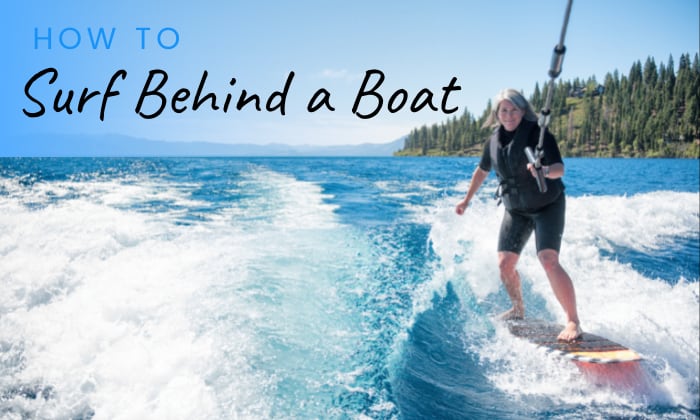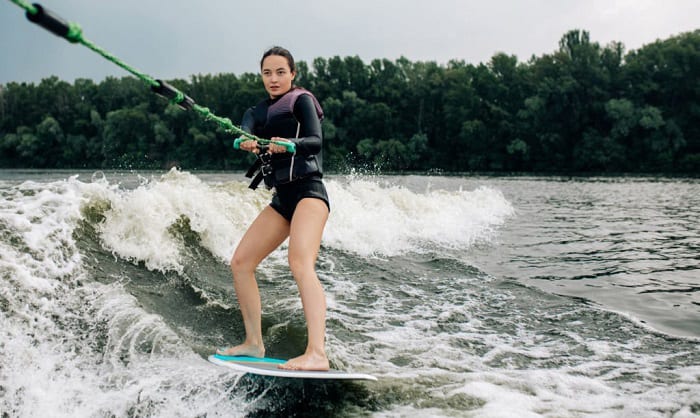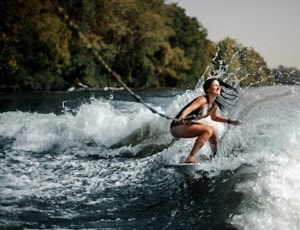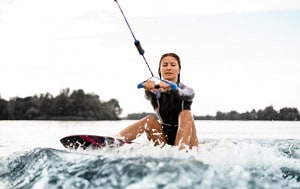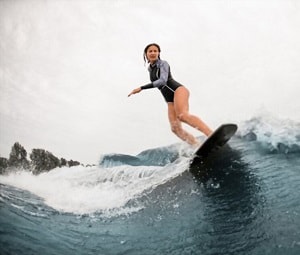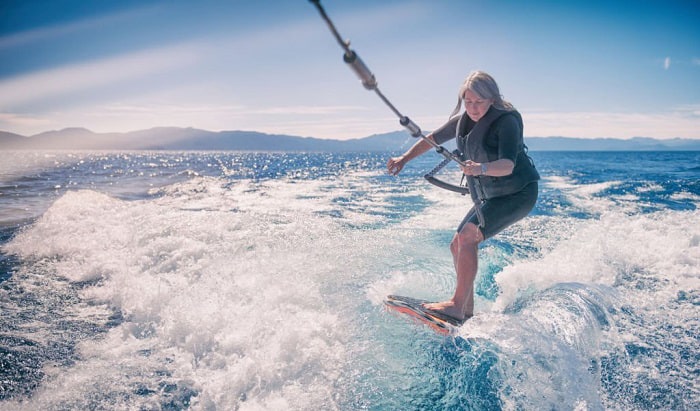Wake surfing serves as a godsend for folks who don’t want to miss out on the unique thrills only a combination of waves and speed can provide. Despite it being more challenging than wakeboarding, it’s still generally not difficult to get the hang of.
If you’ve been meaning to learn how to surf behind a boat, consider this guide as that much-needed gentle push to get off to a great, comfortable start. You’ll learn every essential step, preparation, and key facts you need to remember to make the experience safe and enjoyable every time.
Table of Contents
Things to Prepare
You’ll always need to do this with a rope to get on the board and guide yourself in the initial phases, so prepare the following:
- Wake surf boat or any boat with an inboard motor
- Life jacket
- Board shorts
- Surfing rope
- Surfboard suitable for the rider’s size
I’ll be explaining how to wakesurf for beginners in the following steps. Of course, you’ll need another person to drive the boat – someone licensed and used to surfing behind boats, preferably.
Steps to Correctly Surf Behind a Boat
1. Get yourself in position.
Getting up on the board proves to be one of the trickiest parts to master for people who want to learn to wakesurf. Firstly, it’s about being mindful of how you position your head, as otherwise, you might end up with water splashing all over your face (which is never a pleasant experience!)
Start by positioning yourself with a rope’s handle in your hands and the board a good distance away (about 15 to 20 feet from the boat).
Then, sit in the water with the rope in your hands and the board laid flat in front of you. Your arms should rest on top of your knees. Raise and rest your heels on top of the board, with your toes pointing up toward the sky.
2. Slowly get up on the board.
Once you’re all set, you can signal the driver to start getting the boat into gear. You’ll feel the rope becoming tense. That should give you the sign to start preparing to get up onto the board.
Begin by digging your heels into the board in such a way that its top will flip to face you and your feet will land on it. Let your knees draw into your chest.
Your body should assume and maintain a crunch position as you hoist yourself up onto the board to stand on it. Dig your heels in to keep yourself stable as you stand.
With an experienced driver who knows how to put the boat into gear and accelerate at the right times, standing on the board should be a breeze. For instance, he or she should have good awareness of when to pick up enough speed to help pull you up onto the board.
Here are some dont’s when performing this action:
- Don’t attempt to pull yourself on top of the boat; you’ll likely lose your balance if you do so.
- Don’t lay your head back unless you want what’s called a “royal flush” of water splashes I’ve said above.
3. Get the right balance then start surfing the waves.
Do the regular surfing position to be safe. Plant your right foot at the back and left at the front while maintaining a firm grip on the rope handle. If you’re more comfortable with the reverse of this stance, then go ahead.
Once you hit that balance sweet spot, it’s time to start surfing the waves. Slowly get close to them to avoid being pushed back and getting your balance disturbed once again.
I know wakesurfing strictly means surfing behind a boat without rope, but you still can’t do without one, especially in this phase.
Here are a few tips worth remembering:
- Do a posture check as you get near a wave. I do this by using my free hand to push against my lower back to help me stand upright and maintain stability as I approach a wave.
- Don’t drag the rope and let a portion of it dangle behind you as you wakesurf behind a boat! The chances of that wayward length wrapping itself around you (or even strangling you) may be low but not impossible.
4. Toss that rope and start having fun with speed control.
You’re learning to wakesurf, after all, not wakeboard. The best time to do this is when you feel the rope begin to slacken as you’re surfing. That means you’re balancing by yourself.
Don’t be pressured to do this asap. Only chuck the rope once you’re 100% comfortable with your footing and posture and the length remains slack for a relatively long time. I always throw it toward the boat, but you can also toss it over the wave.
Getting the hang of the waves? Start adjusting your wakesurfing speed then. These are some essential tricks I subscribe to:
- Basically, it mostly hinges on putting weight on either your front or back foot. Pressing down with your back foot slows you down while doing so with your front foot speeds you up.
I prefer this instead of using toes and heels, but ultimately, it’s your choice.
- Want to slow down quickly? Steer the board toward the side of the wave.
- A lot of people struggle to stay on the wave. Beside not rushing to get on the wave, one way I always manage to ride on it is to make sure my feet stay positioned right on the center of the board.
I also regularly put pressure on the soles of my feet while maintaining proper posture to help cut down the line of the wave.
Also, learn to drive with your hips and not your shoulders. I usually stay on the wave by moving my hips forward, as it helps pitch the board down the wave.
This video shows a simple, but effective demonstration of speed control when surfing, so I suggest you watch it:
FAQs
Is surfing behind a boat hard?
It’s generally more difficult than skiing, but whether it’s harder or easier than wakeboarding is still up for debate. Overall, you get plenty of control when wake surfing, in terms of balancing, positioning, and driving the boat, so it’s not incredibly hard, per se.
Can you surf behind a normal boat?
Lastly, I hope that you’ll be able to dispel the thought that you can surf behind any boat for good. A boat with a V-drive design and a propeller safely under the hull will do.
- If you’re going to be using a pontoon boat, it’s best to use one that’s more modern and performance-oriented.
- You can use a ski boat, but you’ll need to put the right amount of weight at the back of the vessel to tilt the hull I don’t really recommend it, since it’s not designed for this activity, and figuring out the right mass to add may take time.
- Wakesurfing behind outboard is dangerous. Also, it likely won’t be able to give you a genuine surfing experience, to begin with.
Conclusion
I hope I’ve given you a reliable, beginner-friendly guide on how to surf behind a boat with all the tips and facts shared here.
At best, you have to become familiar with key stages such as being able to stand on the board with the right balance, knowing how to approach the wave, and controlling your speed.
Remember the pointers about all three steps above as well as the safety guidelines shared here to make the experience a blast every time!

“My intention from the first day establishing Boating Basics Online is to provide as much help as possible for boaters who want to experience a first safe and convenient trip. So feel free to join us and share your beautiful journeys to the sea!”

